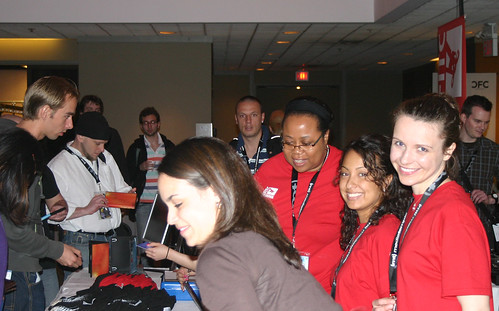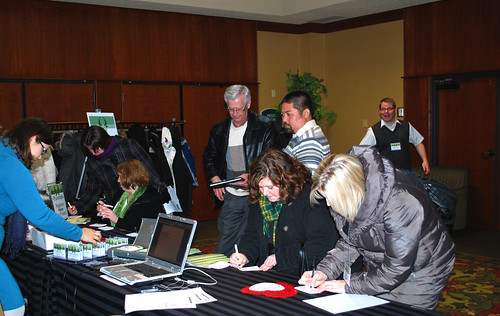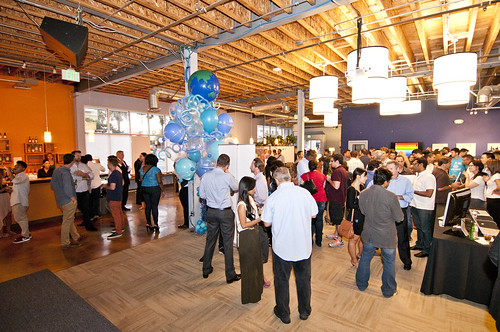
This is the second in a series of posts about running a successful fundraising event night, written by event service professionals. Event service professionals help troubleshoot technology, advise on using event software, and ensure everything goes as smoothly as possible at auctions.
I polled some event service professionals about what big mishaps they’ve seen at nonprofit events over the years. And while the list is quite long, it really boils down to a few simple errors that bring registration to a stand-still; annoy guests; and make an event professional’s job a lot more challenging.
So I present to you: the 10 things you really don’t want to do at your event!
And if you’ve done these before, take heart: you’re not alone. Most are easy fixes, and you’ll see a huge uptick in how much your guests enjoy your event.
1. Don’t make volunteers do everything at registration.
One of the most common mistakes people make is thinking volunteers are superhuman—capable of giving out a catalog and bid card; collecting an address; checking a guest in, and swiping their credit card all in one or two minutes. (Hint: that’s too much!)
While volunteers are selfless, wonderful, and helpful, they are still human.
Try to limit what you ask volunteers to do with each guest—every extra task adds up over a few hundred guests. Try delivering bid cards to tables in packets, instead of handing them out at registration. Consider registering credit cards online, in advance, and having volunteers waiting to collect addresses on clipboards or tablets.
2. Don’t sell stuff or ask for donations right when they show up.
The surest way to turn somebody off to your nonprofit? Try and sell them extra stuff right when they arrive!
Hold off on selling those additional raffle tickets or merchandise until people are actually checked-in and inside the event venue. It’s one less thing for your volunteers to do during registration, and your guests won’t feel like piggy banks.
3. Don’t avoid the necessary prep beforehand, hoping your event service professional will do it for you.
Your event is not really the best time to test how capable your event help is. No amount of expert assistance can make up for not doing enough planning and preparation in advance.
Don’t wait until the last minute to print guest lists; verify that your data is complete; buy a package of bid cards; or coordinate item pickup. Show up to your venue on the morning of with those guest registration forms and other important materials ready to go—give yourself (and everyone else) one less thing to stress about!
4. Don’t crowd your registration space.
It can get hectic with so many people working in the same small space—volunteers sitting at registration tables; more volunteers behind them working as runners and grabbing bid packets; and a staff member seated with a computer; ready to troubleshoot problems should they pop up. That’s a lot of people!
Leave them plenty of room to breathe, so your runners can move without tripping over each other’s feet, and your event services professional can quickly get to a registration station to help out when needed.
Don’t have more than two computers per eight-foot table. The illusion of space gives a sense of organization and calm!
5. Don’t skimp on registration stations.
What one thing has the greatest impact on guest experience? How quickly your attendees get into your event. If they have to wait in line for ages and ages, that sets the tone for the whole night. People who have a smooth check-in process, will start out having a better experience and spend more money.
So don’t make those lines long by properly staffing check-in. Also have plenty of computers and/or tablets, and enough volunteers to use them. To avoid long lines we recommend one station for every 75 guests you expect.
6. Don’t have a separate VIP line.
A great way to alienate most of your guest list, and make one of your registration lines useless, is to mark out a separate VIP line.
Most guests don’t know if they’re VIP or not, and guests who don’t qualify will certainly feel second-class. You’ll end up with one line never getting used, and a registration volunteer that could have been helping to move your other lines along faster.
7. Don’t forget to direct people which way to go.
People like to know where they’re supposed to go. Without some stanchions and ropes to mark off your waiting lines, the registration area can get chaotic. And, frankly, it’ll look messy!
Create some kind of line organization so people know when it’s their turn, and definitely have volunteers on hand to guide people to the next open registration station.
8. Don’t put loud music right next to registration.
The best way to frustrate guests is to place a giant speaker, piano, or live guitar player right next to registration. They’ll definitely be irritated when they can’t hear the important information from volunteers about where to participate in the silent auction, or how to get their phone set up to bid online.
Save the music for your silent auction room, bar area, or ballroom!
9. Don’t wait to assign bid numbers, figure out event flow, or get those few last names from sponsors.
There’s no magic last-minute genie to fix all those outstanding guest list issues—you’ll have to do it yourself to make sure your event goes off without a hitch.
Call those sponsors who haven’t yet given you all their guest names, and keep following up until the big day! Tell them it’s so their guests will have a better experience from the beginning of the event.
Assign bid numbers to bidders in advance of the event so you can print the right information on bid cards or bid packets. People will want to know their number and where they’re supposed to sit.
Where are guests coming from? When and where will they pick up their auction winnings? When will you be ready to check them out? Be realistic in your timeline and give yourself plenty of buffer time between parts of your program, in case some unexpected difficulty comes up.
10. Definitely don’t forget creating a plan to troubleshoot issues as they arise.
Have a computer station set aside just for solving issues as they come up—a guest not on the guest list, a sponsor who needs to add someone to their table, that sort of thing. That way, you can get them out of the main line while you figure out their issue, and the rest of check-in can move along smoothly.
Put a staff member in the know in charge at your troubleshooting station, or an event service professional who knows how to add new guests and fix problems. Keep the line moving!
Want more of this great insight?
Continue reading with the first article in this series “Best Practices for No-Wait Event Registrations.“



